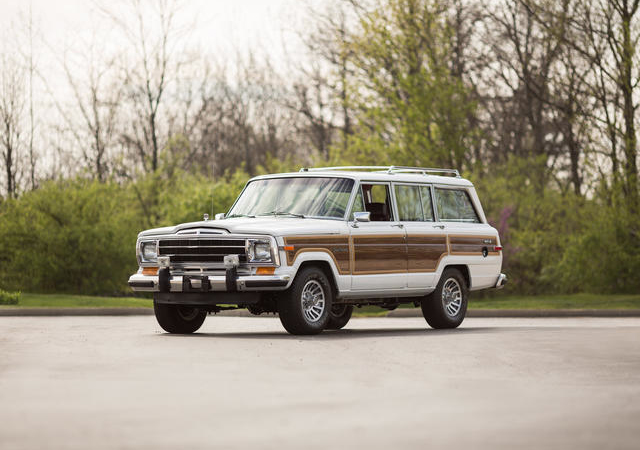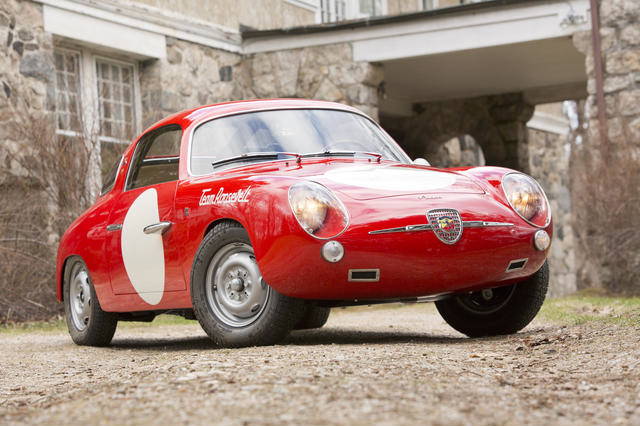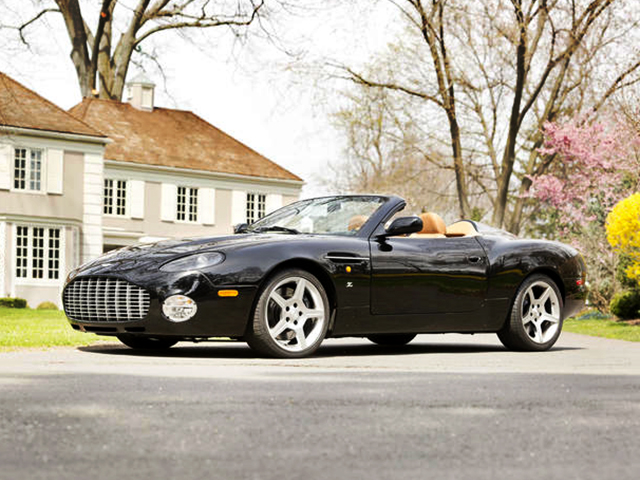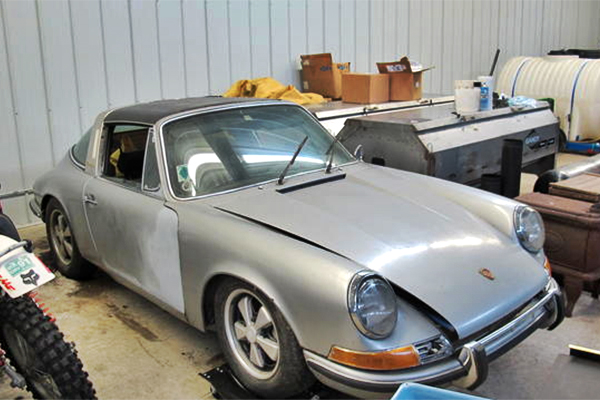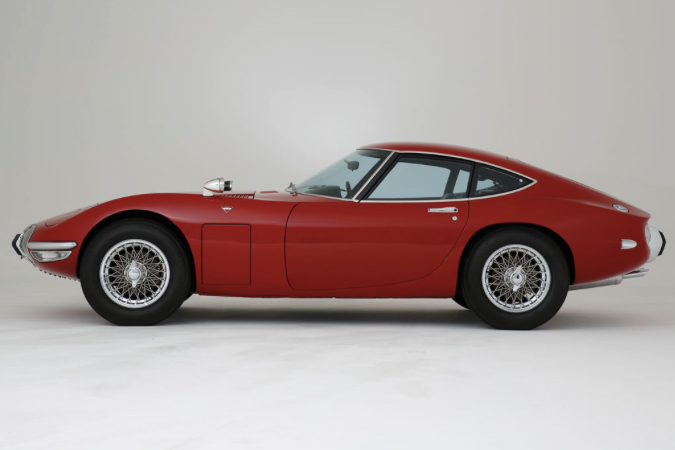Lot 310 – 1958 Alfa Romeo Giulietta Spider
Without Reserve. Estimate: $25,000-30,000 moto+match estimate: $25,000
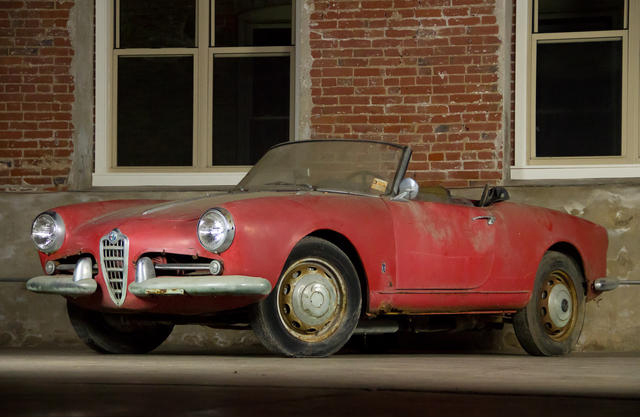
With the introduction of the 1300cc Giulietta in 1954, Alfa Romeo established the ‘small car, big performance’ formula that would characterize its finest offerings from that point on. The Giulietta’s arrival caused a sensation; demand quickly outstripped supply, causing Alfa Romeo to rethink its production strategy and become a high volume manufacturer. The original Bertone-designed Giulietta Sprint Coupe of 1954 was soon joined by a more practical Berlina Sedan and a charming Spider, the latter sporting elegant coachwork designed and built by Pinin Farina.
According to factory records from Alfa Romeo’s Centro Documentazione, this Giulietta was completed at the Milianese Alfa Romeo plant on July 21, 1958. The new left hand drive Spider was finished in a sporting red color, configured as left hand drive, and destined for the United States, where legendary importer Max Hoffman Motorcar Company later took delivery the following month. The new Spider was sold to a Mr. Hillman, residing in Florida and Illinois, and records show service and maintenance work performed while in Hillman’s ownership. Hillman would keep the Giulietta until 1961, when he traded it in with circa 15,000 miles, at the Fancl-Bogan Chevrolet dealership in Oak Park, Illinois. In July of 1961, the Alfa Romeo was purchased by Mr. John A. Clark, a chemical engineer from Stroudsburg, Pennsylvania. Mr. Clark used the little Red Spider over the next decade, before taking it off the road in 1976, with just 52,239 miles recorded. It remained in storage until Mr. Clark’s passing in the late 2000s, when purchased by the consignor. Accompanied by an abundance of receipts, records and the factory tool kit, this barn find Guilietta is an incredible original and complete example. The perfect candidate for a restoration, this low mileage Alfa Romeo still retains most of the factory finishes, as well as the rare Motorola radio surely mounted when new at Hoffman’s. This Giulietta has been spared from mediocre restorations or modifications over the years, and really deserves to be put back on the road.
Lot 317 – 1988 Jeep Grand Wagoneer
Without Reserve. Estimate: $25,000-30,000 moto+match estimate: $35,000
Luxury SUVs are nothing new, but when the Jeep Wagoneer came out in 1963, it was something genuinely different. Combining the rugged attributes of a truck with the luxury of a sedan made for a unique, segment breaking vehicle. So successful was the model that it survived until 1991. In nearly three decades of production, the Jeep’s architecture changed little. Sporting a body-on-frame design with solid axles and leaf springs all around, it was a classic example of “if it ain’t broke, don’t fix it!” Power was delivered to all four wheels via a viscous coupling center differentials allowing rear-wheel drive only operation for a bit of added fuel economy, if you consider 13 miles to the gallon ‘economical’. Off road the Jeep was capable of going toe-to-toe with a new Range Rover and on road its handling proved adequate, if a bit primitive given its somewhat hoary underpinnings. In a July 1988 comparison test against a Range Rover, Car and Driver waxed about the Grand Wagoneer’s, “leather upholstery trim and, both inside and out, lots of chrome and fake wood” not to mention copious power features. While performance didn’t exactly light the heather afire, taking 13 seconds to get to 60mph, the Range Rover took even longer to do the duty and still cost a third more.
This three-owner from new Grand Wagoneer was delivered new to an elderly couple in Northern California in June of 1988. From the final iteration of the Wagoneer, it benefited from all of the upgrades that would be bestowed upon the model making it the most comfortable and desirable version available then and now. Sparingly used by its first owners, it was sold to another older couple in 1999 before coming to the collection of the current vendor a year ago. Showing only a bit over 68,000 original miles, it is completely original. A luck recipient of two and a half decades of dry California climates, meticulous maintenance and minimal use has kept this white over burgundy Jeep looking extra fresh. The obvious decedent of the great woodies of yore, this Jeep is ready to continue its tradition of shuttling the family from the wilds of Westchester to the beaches of Southampton in comfort and style!
Lot 378 – 1959 Fiat-Abarth 750 Record Monza Bialbero Coupé by Zagato
Estimate: $175,000-250,000 moto+match estimate: $250,000
An innovative concern with a sporting pedigree second to none, Abarth branched out from producing induction and exhaust systems into selling performance kits for – mainly FIAT – production cars, later building a succession of aerodynamically stylish sports prototypes and limited-series production cars. One of Carlo Abarth’s most successful series of GT cars was based on the FIAT 600, the first of these handsome little Zagato-bodied coupés – the 750 – appearing in 1956. The 600 chassis was used with scant modification apart from changing spring rates and up-rating the front brakes to twin-leading-shoe operation, yet despite this apparent handicap coped remarkably well with the Abarth’s greatly increased performance. The next stage of development saw the 750 equipped with a double-overhead-camshaft engine designed by Gioacchio Columbo, designer of the first Ferrari V12s that helped liberate 47 51bhp from the tiny engine, these models thus equipped being dubbed ‘Bialbero’ (Twin-cam). Abarth’s diminutive coupés were soon dominating the small-capacity classes in international GT racing. Indeed, in North American SCCA events the 1.0-litre Abarth was obliged to compete against rivals displacing up to 3.8 litres and still proved capable of winning!
The current owner acquired 550486 in the early 1980s and in doing so began a labor of love in terms of restoration and research. His extensive work has enabled him to make deductions about the early history of the car which are both fascinating and uncontested by other aficionados of the marque and model. At the time of its acquisition, the car was an engineless rolling chassis, but a number of clues to its importance were very clear to its knowledgeable buyer. Most notable was the required holes for fixing the fuel pressure regulator bracket – another Bialbero exclusive feature. So the car was clearly one of these rare brethren of Abarths.
The next base point for research was the discovery of a series of three drilled holes in the passenger side door which had long since been covered by filler and paint. These holes correlated perfectly to a door mounted racing number light which cars known to be in the USA and to have run at Sebring in 1959 carried by regulation to make their racing numerals visible at night. That narrowed the field to one of the four cars that had run at that event that year for Team Roosevelt.
Before one pauses to question a link to the President, the answer is ‘yes’, the Roosevelt Automobile Company was run by FDR Jr. They were East Coast Importers for Fiat and would continue this by developing a relationship to run Abarth race cars also. As ever in the course of racing the idea was to encourage the old adage of “race on Sunday, sell on Monday”, but Roosevelt Jr.’s thinking was a little further developed in that he believed “that Americans could sell a car better to Americans”. For the race team John Norwood was their manager and ace mechanic Jim McGee prepped their entries, the drivers represented a series of experienced stalwarts who could be trusted with the brand. Sebring ’59 was the debut race for this new team.
A period black and white image of the four cars sent ex-Zagato Works from Italy for the Sebring Event shows that two were finished in a dark color and two in a light color, of the two darker colored cars, one had a dark interior, the other a light interior, and the same for the lighter cars, thereby actually making each different in its livery. Differentiating them further, when they were run at Sebring they were still wearing Turin license plates, TO-712 and TO-487 adorned the two darker colored cars. These are actually understood to be ‘trade’ plates, suggesting that there can’t have been much time to spare between their leaving the works and being campaigned in Florida. On the basis of surviving period images of the two darker colored cars, which turns out to have been red in color period images, this car has been deduced by its owner to be the #62 car, which wore the Torino plate “TO-712”. Assuming this to be an accurate statement, car #62/TO-712 would contest between 10 and 13 races in the ’59 Season after Sebring, including Daytona, Bridgehampton, Road America, the Watkins Glen Grand Prix and the International Bahamas Speed Weeks at the end of that year, with respectable low double digit finishes overall.
By the end of 1960, 550486 is known to have been the property of J. William Denton, as he ran the car at the Savannah Race Track in November 1960, when its ‘Team Roosevelt’ marking had cleverly been given the prefix of ‘Ex’! The owner was able to trace J. W. Denton’s son, who produced a copy of Denton’s first title registration on acquisition of the car, it clearly denoting this identity and the engine number digits following the VIN. From his conversations with the younger Denton, he had recalled his father acquiring a number of Abarths from Team Roosevelt, but only one Bialbero and that proved to be his favorite apparently. Denton is known to have run the car at the Chimney Rock Hillclimb in 1961, and a series of other events. According to John de Boer’s well researched archive, the subsequent chain of ownership ran 1971-1974: Steve Doran; 1974-1976: Doug Huffman; 1976-7: Herbert H. Bailey of South Carolina; and then 1977-1984 – GTS Motorcars of Florida, before it was acquired by the present owner in 1984. All the while the research was continuing, and correct parts being accrued, the owner waited patiently before beginning its restoration. This began in earnest almost 20 years ago. Its structural repairs were carried out by the owner with sheet metal repairs to the aluminum bodywork by Tivvy’s Autocraft, this was then followed up with the paintwork at Alfa’s Unlimited. Automotive Restorations of Stratford, Connecticut trimmed original Zagato seat frames provided by the owner in a light tan vinyl and made new carpets in Wilton Wool, the finish of the cabin being slightly improved over the original having a Nardi wood rim steering wheel in place of the plastic one it would have worn new.
For the mechanical aspect, the owner was able to draw on his own stores of spares that had been accrued over many years, a number of the more significant pieces coming from Jeff Vogel, who in turn had bought them from Jim McGee’s shop in Watermill, Long Island, these included a spare long distance fuel tank, oversize Abarth Alfin front drum brakes, and new/old stock Bialbero racing exhaust – the motoring definition of ‘hen’s teeth’ quite literally.
Further searches had produced a period correct Bialbero engine motor, which itself created something of a conundrum. The engine was number 600319, which by Fiat records was the original fitted to 550486, yet a separate document sourced by the current owner shows that 600319 was fitted to car 544303 on March 25, 1959, when that car was listed on a statement of sale to Gene Williamson by Team Roosevelt – Williamson being the driver of car #65 at Sebring that year. As ever in the history of racing teams it seems likely that 600319 had migrated from its original mount very early on in its life, but today thanks to the perseverance of its current owner it is back with the Fiat-Abarth it apparently left the Works in. Naturally, since the intention of the owner was to race the car, this numbered block is actually stored and goes with the car, while it is currently running a ‘hot’ engine built around a separate 600 unit.
Post-restoration, 550486 has been campaigned with some regularity by its custodian, being run in VSCCA meetings from 1996 to 2000, at the Lime Rock Historic Races on numerous occasions and also displayed here at the Greenwich Concours d’Elegance in 2000 and at the Lime Rock Sunday in the Park Concours last year, where it was rewarded with First in Class.
After three decades of research, restoration, ownership and use, during which it seems virtually every stone has been upended, the seller has made the difficult decision to part with the car and forward it to another enthusiast. While that elusive final jigsaw puzzle piece of paper that conclusively documents it as the #62 Sebring car from 1959 remains still yet to be found, it seems hard to question the current owner’s conclusion based on his research. Regardless of this ultimate detail, the car is a fastidiously accurately restored example of these ‘Giant-Killer’ Abarths, which certainly had an active period racing career and could today provide its next owner with an enjoyable vintage racing mount.
Lot 389- 2003 Aston Martin DB AR1
Bonhams Estimate: $170,000-190,000 moto+match estimate: $210,000
Aston Martin renewed its fruitful relationship with renowned Italian styling house of Zagato, most famously begun with the DB4GT Zagato of the 1960s, after a meeting between Elio Zagato’s son Andrea and Aston Martin CEO Dr Ulrich Bez at the Pebble Beach Concours d’Elegance in 2001. The result was a stylish coupé, based on the DB7 V12 Vantage supercar, recalling the sublime looks of the original DB4GT Zagato. So favorable was the DB7 Zagato’s reception that it was decided to produce an open car in similar vein: the DB AR1. Designed with the California weather in mind, and a Roadster in the proper tradition with no hood and space for just two people, the DB AR1 was previewed by a select group of potential customers to gauge reaction. The car was so well received on its debut at the Los Angeles Auto Show in 2002, that all 99 of the proposed limited edition were purchased. Powering the new open supercar was a developed version of Aston’s state-of-the-art, 6.0-liter V12 enjoying a boost in maximum power to 435bhp, some 20 horsepower more than the DB7 Vantage. This power increase together with more torque, a revised final drive ratio and ‘active’ sports exhaust system produce a noticeable improvement in mid-range performance, where it is most useful in everyday driving. An AP twin-plate racing clutch combined with a revised quick-shift gearlever for the six-speed manual transmission enable the driver to maximize use of the increase in power and torque and enjoy a faster gear-change. Acceleration can only be described as stunning, 60mph arriving in just 4.9 seconds, while its top speed of 185mph makes the DB AR1 the world’s fastest true roadster. Above all, the DB AR1 was designed to be a true ‘driver’s car’, equally at home on the autobahn or challenging back road. This is a car that beckons you to look for places to go. Restraining this superlative high performance are equally exalted brakes: Brembo racing-style grooved discs – 335mm at the front, 330mm at the rear – gripped by alloy four-pot calipers assisted by an improved brake booster unit and moderated by Teves ABS. Power is transmitted to the road via a limited-slip differential to special multi-spoke 19″ alloy wheels (8″/9.5″ f/r) incorporating revised offset to give a wider track, shod with low profile Yokohama tiresThe interior boasts electrically controlled sports seats, six-speaker Becker stereo radio cassette system with 6-CD changer, alarm and immobilizer with remote central locking and trunk release. There is electronic traction control and power-assisted rack and pinion steering.
This fantastic, low mileage AR1 Roadster has lived a charmed life. Purchased by its first owner from Aston Martin of Beverley Hills on December 4th, 2004 with 140 miles on the clock, it carried an original sticker price of over $250,000. Finished in Bowland Black over Light Tan hides, it enjoyed the California sun in the care of its original owner until the summer of 2010 when the current vendor acquired the roadster, the 26th of 99 DB AR1s constructed. Having covered less than 3,800 miles since leaving Newport Pagnell, it has received continuous, careful maintenance and shows well today. Replete with its original Monroney sticker, books, umbrellas, and car cover, this barely used, coachbuilt roadster is now ready to move onto to its third lucky owner.
Lot 403 – 1970 Porsche 911E Targa
Without reserve. Bonhams Estimate: $8,000-12,000 moto+match estimate: $20,000
This silver Targa, with black leather interior, was originally acquired on May 4, 1970 by Irving Rose of Northbrook, Illinois in Stuttgart, Germany through the Tourist Delivery Program. Rose traded the car through Bryntesen Porsche-Audi Inc. of Hinsdale, Illinois with registration receipts showing Bryntesen selling it to Michael Burns in February 1978. The next keeper of the Porsche was Raymond Paulis followed by David Thompson, although Thompson’s date of acquisition is unknown. Purchased by the vendor in the summer of 2004 with the intention of restoring it; it instead has sat in climate-controlled, dry storage since 2004 with little progress made. The original MSO and other paperwork are available with the car together with the owner’s manual plus sleeve and Blaupunkt radio service manual. Substantially complete, unmodified from original specification, and with only minor damage to the passenger door, this 911E is a wonderful base for restoration. The chassis appears to be remarkably straight and intact, showing penetrating rust in only a few places like the driver’s side battery box, and the engine is free but not currently running. The car was easily pushed out of storage once one front brake caliper was released. The interior is largely complete but dirty and worn. With early Porsche 911 continuing their upward trend, this rare 911E Targa is an excellent opportunity to acquire a lovely, documented car that will provide many happy miles following a thorough restoration.
